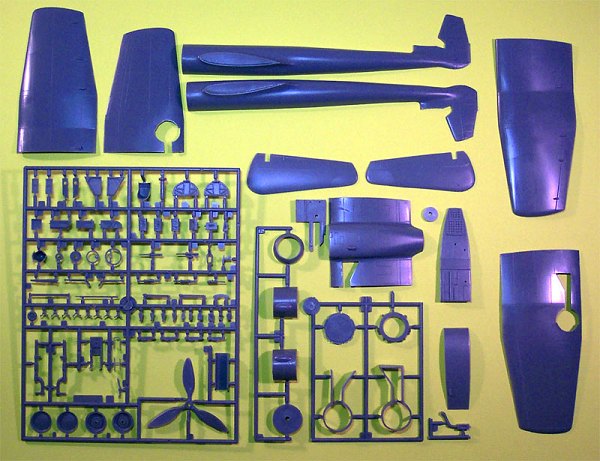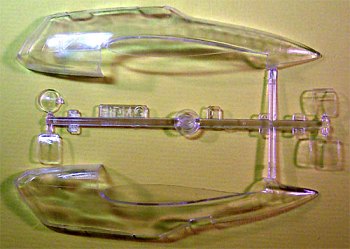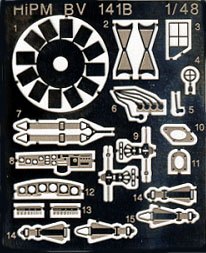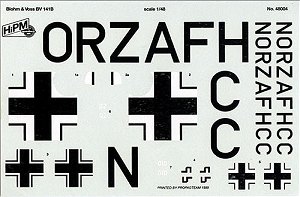
|
KIT: |
HiPM 1/48 BV-141B |
|
KIT # |
48004 |
|
PRICE: |
$49.98 MSRP |
|
DECALS: |
two options |
|
REVIEWER: |
Matt Swan |
|
NOTES: |
Short run |

|
HISTORY |
The story of the Bv-141 began in the late 1930s when the Luftwaffe was shopping for a light ground attack aircraft to supplement the Junkers Ju-87 Stuka, which was already in production. Focke Wulf proposed its Fw-189, while at Blohm & Voss, designer Richard Vogt came up with what is certainly the most asymmetrical airplane ever flown.
Although the firm is best known for building Germany's World War II flying boats and was well established as a manufacturer of sea going vessels, Blohm & Voss is most notorious for its profoundly eccentric Bv-141. It was precisely this eccentricity that doomed an otherwise operable and reportedly reliable airplane.
Blohm & Voss actually undertook to build it at their own expense. It worked, but pilots refused to trust such unorthodox lines and the British laughed at them. The airplane that emerged from Vogt's drawings was remarkably aerodynamic, the fact of which he'd already known. It was 39 feet 10 inches long, with a wingspan of 50 feet 8 inches and a weight of 8600 pounds, putting it in almost exactly the same size and weight class as the familiar Messerschmitt Bf-110. Powered by a BMW132 865 hp radial engine, the Bv-141 had a respectable top speed of 248 mph and a ceiling of 29,530 feet, while its 700-mile range was almost twice that of the Fw-189.
The Bv-141 was a very unusual, asymmetric aircraft. The configuration was adopted to give excellent all-round view from a single-engine aircraft. An extensively glazed nacelle was fitted to the left of a slender tail boom. The Bv-141A (with symmetrical tailplane) was an excellent aircraft but the RLM rejected it as underpowered. The more powerful Bv-141B (with asymmetrical tailplane) had some handling problems. Both types had hydraulic problems.
Its first flight, on 25 February 1938, proved the Bv-141 to be more airworthy than its detractors wanted to believe. Over the next two years three Bv-141A prototypes and 10 Bv-141B production aircraft were completed, but the poor bird never shook the stigma of its disfigured appearance and the Focke Wulf Fw-189A was the winner of the contract.
|
THE KIT |

 To the best of my knowledge this is the only kit produced of this
aircraft in 1/48 scale. This kit was released briefly in 1999 and one of
the most unusual features of the kit was the clear gondola section. I’ve
modeled the FW-189A in 1/48 before with a typical arrangement of clear
canopy pieces to complete the large greenhouse on that craft so this
looks to be an interesting alternative to that design. Unfortunately the
central seam runs right through two windowpanes and it will be very
difficult to conceal. The remaining hatches that are located along this
seam are separate pieces and present no problem. With an aircraft with
this caliber of a greenhouse I strongly recommend purchasing a set of
Black Magic masks.
To the best of my knowledge this is the only kit produced of this
aircraft in 1/48 scale. This kit was released briefly in 1999 and one of
the most unusual features of the kit was the clear gondola section. I’ve
modeled the FW-189A in 1/48 before with a typical arrangement of clear
canopy pieces to complete the large greenhouse on that craft so this
looks to be an interesting alternative to that design. Unfortunately the
central seam runs right through two windowpanes and it will be very
difficult to conceal. The remaining hatches that are located along this
seam are separate pieces and present no problem. With an aircraft with
this caliber of a greenhouse I strongly recommend purchasing a set of
Black Magic masks.
Many modelers have complained in the past about the accuracy of Black Magic masks, that they had to cut or trim some individual masks to get a perfect fit. I have used many sets of these and yes, I have had to trim a few, usually one in every set. Did you count the number of windows on this model? I think trimming one mask is not a bad deal verses masking each window individually with tape.
 Okay, enough of that, let’s get back to the
kit. The kit includes 97 injection molded parts in a medium gray plastic
that appears to be of an adequate hardness along with 6 clear parts. The
parts have nicely engraved recessed panel lines and have a nice, smooth
surface. The sprue gates of a normal size and there is no flash to speak
of. The clear parts are clear and not too brittle. Also included is a set
of photo-etched parts for the instrument panels, seat belts, oleo hinges
and engine cooling fan. There is also a small acetate sheet for the
instrument details. Like most kits coming out of the Czech Republic this
one has no locator pins and with some of the larger parts alignment will
require care.
Okay, enough of that, let’s get back to the
kit. The kit includes 97 injection molded parts in a medium gray plastic
that appears to be of an adequate hardness along with 6 clear parts. The
parts have nicely engraved recessed panel lines and have a nice, smooth
surface. The sprue gates of a normal size and there is no flash to speak
of. The clear parts are clear and not too brittle. Also included is a set
of photo-etched parts for the instrument panels, seat belts, oleo hinges
and engine cooling fan. There is also a small acetate sheet for the
instrument details. Like most kits coming out of the Czech Republic this
one has no locator pins and with some of the larger parts alignment will
require care.
The decals provided with the kit are manufactured by Propag Team. The registry looks good but I am a little worried about the color density. I am concerned that the underlying camouflage pattern may show through the large crosses on the upper wings. Registry markings are provided to do 5 of the 10 “B” models produced.
The instruction booklet is very nice and is actually a booklet. It is 12 well printed pages that includes a brief history of the aircraft in English and in Czech (?).There is a nice color code chart and parts breakdown just inside the cover, the individual construction steps are very well illustrated and the camouflage and marking directions are very well done.
|
CONCLUSIONS |
Without a doubt this is one of the more unusual and, in some peoples opinion, one of the ugliest aircraft of the Second World War. It is an excellent addition to any Luftwaffe collection. Due to the large greenhouse and the skills that will be required to complete that structure, I would not recommend this for a novice modeler but for those of some experience. Not only do I recommend purchasing the Black Magic masks but have considered getting a second set to mask the interior of the gondola with so that it could be airbrush rather than painting the exterior RLM02 first and relying on that to color the interior walls. Hmmm, something to think about.
If you would like your product reviewed fairly and quickly by a site that has over 200,000 visitors a month, please contact me or see other details in the Note to Contributors.